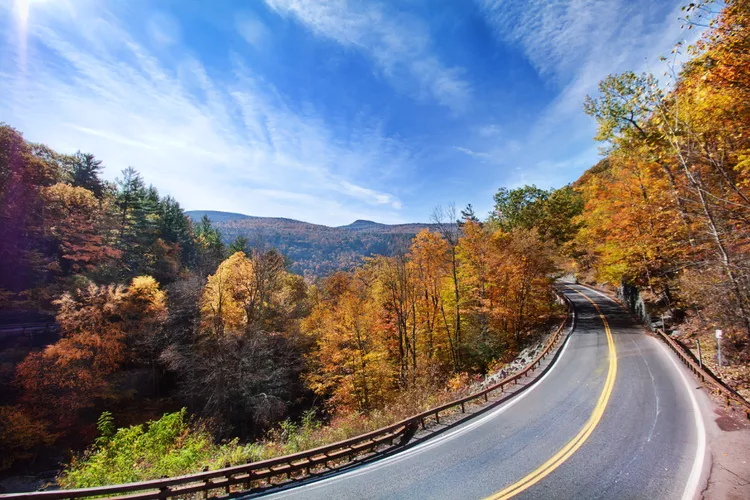Summary
Explore the Scenic Backroads of the Catskill Mountains
New York State’s storied Catskill Mountains are a must-see, so head out on this scenic backroads drive to experience the natural and man-made wonders of this region.
Driving Directions
Directions: From Catskill, New York, follow New York State Route 23 West to Prattsville. Backtrack on Route 23 East to State Route 23A East through the Catskill Park. When Route 23A East ends, head north on U.S. Route 9W to Route 23 East. Proceed across the Rip Van Winkle Bridge (toll), then turn right on State Route 9G South to the left-hand entrance for Olana State Historic Site.
“Welcome to the land of Rip Van Winkle,” reads a sign that greets motorists headed west on Route 23 toward the looming mountain skyline. It was in these ancient, gray sandstone peaks that Washington Irving’s likable character observed strange beings playing at ninepins, quaffed their liquor, and then slept for a night that lasted 20 years. Consequently, storytellers and artists elevated these misty hills sheathed in boreal forests to mythological status long before the region became an accessible and popular vacationland. The legendary scenes captured on canvas and recorded in fables spring to life as you follow the curvy path of this skyward drive.
Point Lookout
In East Windham, be sure to pull off Route 23 at Point Lookout. On clear days, this overlook beside the dramatically situated Captain’s Inn Point Lookout (formerly Point Lookout Mountain Inn) affords views of five states. As Route 23 continues to climb, you’ll enter the Catskill Park, a 700,000-acre area composed of private and public lands in four counties. Since the park was created in 1885, the state’s holdings, protected within the Catskill Forest Preserve, have expanded from 34,000 to nearly 300,000 acres. Notably, with ninety-eight peaks surpassing three thousand feet, the Catskills are one of New York’s most popular winter destinations; Windham, home to the Windham Mountain ski area, is the first of several cheery ski towns you’ll encounter.
Pratt Rock
As you approach Prattsville, you’ll see Pratt Rock, one of the state’s quirkiest attractions. While it’s a stretch to call this New York’s Mount Rushmore, that nickname hints at what to expect. Zadock Pratt, who came to the Catskills as a small boy, labored and scrimped until he could afford to open a tannery on the Schoharie Creek, taking advantage of the abundance of hemlock bark essential to the leather-making process. Within twenty years, he’d amassed a fortune, built an entire town, opened a bank where he minted his own money, and won a seat in Congress. According to local lore, when a panhandling stonecutter wandered through in 1843, Pratt gave him fifty cents to carve his profile on a mountain ledge. Pleased with the result, he commissioned his entire life story chiseled into the cliff face. Visitors who climb the serpentine inclines at Pratt Rock will see a horse, a hemlock, and other symbols, including Pratt’s coat of arms and motto: “Do Well and Doubt Not.”
What began as a monument to vanity became a memorial to Pratt’s only son, George, a Civil War colonel, whose bust was added to the five-hundred-foot rock wall after he died at the Battle of Manassas. Without an heir to his empire, Pratt isn’t remembered far beyond the boundaries of the town he transformed, but in Prattsville, where his 1829 home is now the Zadock Pratt Museum, he remains a legend.
Hunter and Tannersville
You’ll pass public fishing areas as you follow Route 23A East along the trout-filled Schoharie Creek toward Hunter and Tannersville, two charming mountain towns that bustle with visitors during the winter ski, spring fly-fishing, summer festival, and fall leaf-peeping seasons at Hunter Mountain.
The eye-catching, cedar log complex you’ll see on the left before you reach Hunter is St. John the Baptist Ukrainian Catholic Church. The 1962 basilica and other structures were built without nails, in traditional Ukrainian architectural style. Visitors can sample Ukrainian cuisine at the congregation’s summer Sunday buffet brunches. Moreover, the complex is also home to Grazhda Hall, where concerts and cultural events held each summer are open to the public.
North-South Lake
As Route 23A descends into Haines Falls, watch for a left onto North Lake Road/County Road 18, where you’ll find the entrance to North-South Lake: a state beach, campground, and preserve. Hikers who follow the Escarpment Trail to landmark points like Artist’s Rock and the site of the once-grand Catskill Mountain House— which counted three presidents among its elite guests between 1824 and 1941—will enjoy views committed to canvas by Hudson River School painters including Thomas Cole, the father of America’s first school of landscape painting.
Kaaterskill Falls

Kaaterskill Falls, New York’s highest two-tiered waterfall, can be reached via a trail that diverges from the Escarpment Trail, or continue 1.3 miles past North Lake Road on Route 23A to a right-hand-side parking area. Exercise caution when you make your way along the road’s slender shoulder to smaller Bastion Falls, located at the trailhead for the rocky and rooty, moderate half-mile climb to Kaaterskill Falls. The 260-foot double cascade is at its most awe-inspiring in the spring when melting snow and ice increase the rush of water spilling over rocky ledges.
Thomas Cole National Historic Site
Route 23A takes some exhilarating S-turns as you continue your descent toward Catskill. Before you follow Route 23 East across the Rip Van Winkle Bridge, turn left onto Spring Street/Route 385. Tours of Cole’s home and studio at the Thomas Cole National Historic Site offer insight into the remarkable career of this largely self-taught Englishman, whose first depictions of the Catskills, painted in 1825, took the New York City art world by storm. More than seventy other artists would follow Cole’s lead, creating luminous and highly detailed paintings that engendered reverence for the beauty of uniquely American scenes.
Olana
After you cross to the east bank of the Hudson, visit the home of Frederic Edwin Church, Cole’s student and one of the school’s most accomplished painters. Known for his colossal canvases, Church’s largest work was Olana, the estate he created with the help of designer Calvert Vaux. Influenced by the Moorish architecture he’d seen in the Middle East, Church fashioned a home rich in texture and color, constructing and expanding it between 1870 and 1890. He also devoted considerable energy to designing the property’s roads so that spectacular scenes of the Hudson and Catskills were calculatingly revealed.
As you savor these vistas, blissfully little altered by the passage of time, you’ll realize that even if old Rip had slumbered for one hundred years, he still would have descended from the mountains, stroking his beard in bewilderment, yet secure in the knowledge that “there stood the Kaatskill Mountains—there ran the silver Hudson.”
Adapted from Backroads of New York by Kim Knox Beckius, a coffee table book featuring directions, narrative, maps and photography for 28 scenic drives in New York State. Reprinted with permission.





